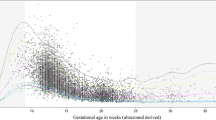Abstract
Purpose
To determine whether the concentration of hyaluronan (HA) in follicular fluid predicts implantation success following embryo transfer.
Methods
Follicular fluids from 170 IVF patients were tested by ELISA for HA concentration.
Results
The mean (standard error) HA concentration in follicular fluids was 158.0 (21.9) ng/ml from women whose embryos did not implant, 220.0 (21.3) ng/ml from women in which one embryo implanted and 239.3 (40.1) ng/ml from women with 2–3 implantations (implantation vs. no implantation p = .019). The HA level was unrelated to maternal age, number of oocytes harvested or fertilized or number of embryos transferred. Follicular fluids from women with an endocrine problem had a lower mean HA level (142.0 ng/ml) as compared to women undergoing IVF due to male factor infertility (257.3 ng/ml) (P = .05).
Conclusions
HA in follicular fluid is decreased in women with unsuccessful implantation or with an endocrine disorder. A woman’s level of HA production may influence the potential for implantation of her embryos.


Similar content being viewed by others
References
Saito H, Kaneko T, Takahashi T, Kawachiya S, Saito T, Hiroi M. Hyaluronan in follicular fluids and fertilization of oocytes. Fertil Steril. 2000;74:1148–52. doi:10.1016/S0015-0282(00)01586-7.
Suchanek E, Simunic V, Juretic D, Grizelj V. Follcular fluid contents of hyaluronic acid, follicle-stimulating hormone, and steroids relative to the success of in vitro fertilization of human oocytes. Fertil Steril. 1994;62:347–52.
Carson DD, Dutt A, Tang JP. Glycoconjugate synthesis during early pregnancy: hyaluronate synthesis and function. Dev Biol. 1987;120:228–35. doi:10.1016/0012-1606(87)90120-5.
Gardner DK, Rodrigez-Martinez H, Lane M. Fetal development after transfer is increased by replacing protein with the glycosaminoglycan hyaluronan for mouse embryo culture and transfer. Hum Reprod. 1999;14:2575–80. doi:10.1093/humrep/14.10.2575.
Sato E, Tanaka T, Takeya T, Miyamoto H, Koide SS. Ovarian glycosaminoglycans potentiate angiogenic activity of epidermal growth factor in mice. Endocrinology. 1991;128:2402–6.
Campbell S, Swann HR, Aplin JD, Self MW, Kimber SJ, Elstein M. CD44 is expressed throughout pre-implantation embryo development. Hum Reprod. 1995;10:425–30.
Yaegashi N, Fujita N, Yajima A, Nakamura M. Menstrual cycle dependent expression of CD44 in normal human endometrium. Hum Pathol. 1995;26:862–5. doi:10.1016/0046-8177(95)90008-X.
Loutradi KE, Prassas I, Bili E, Sanopoulou T, Bntis I, Tarlatzis BC. Evaluation of a transfer medium containing high concentration of hyaluronan in human in vitro fertilization. Fertil Steril. 2007;87:48–52. doi:10.1016/j.fertnstert.2006.05.060.
Friedler S, Schachter M, Strassburger D, Esther K, Ron El R, Razial A. A randomized clinical trial comparing recombinant hyaluronan/recombinant albumin versus human tubal fluid for cleavage stage embryo transfer in patients with multiple IVF-embryo transfer failure. Hum Reprod. 2007;007(9):2444–8.
Urman B, Yakin K, Ata B, Isiklar A, Balaban B. Effect of hyaluronan-enriched transfer medium on implantation and pregnancy rates after day 3 and day 5 embryo transfers: a prospective randomized study. Fertil Steril. 2008; In press.
Neuer A, Lam KN, Tiller FW, Kiesel L, Witkin SS. Humoral immune response to membrane components of Chlamydia trachomatis and expression of human 60 kDa heat shock protein in follicular fluid of in-vitro fertilization patients. Hum Reprod. 1997;12:925–9. doi:10.1093/humrep/12.5.925.
Laverga H, De Sutter J, Van der Elst J, Dhont M. A prospective randomized study comparing day 2 and day 3 embryo transfer in human IVF. Hum Reprod. 2001;16:476–80. doi:10.1093/humrep/16.3.476.
Turley E, Moore D. Hyaluronate binding proteins also bind to fibronectin, laminin, and collagen. Biochem Biophys Res Commun. 1984;121:808–14. doi:10.1016/0006-291X(84)90750-2.
Simon C, Frances A, Pellicer A, Polan ML. Cytokines in implantation. Semin Reprod Endocrinol. 1995;13:142–51.
Turley EA, Noble PW, Bourguignon LYW. Signaling properties of hyaluronan receptors. J Biol Chem. 2002;277:4589–92. doi:10.1074/jbc.R100038200.
Bollyky PL, Lord JD, Mascewicz SA, Evanko SP, Buckner JH, Wight TN, et al. High molecular weight hyaluronan promotes the suppressive effects of CD4+CD25+ regulatory T cells. J Immunol. 2007;179:744–7.
Author information
Authors and Affiliations
Corresponding author
Additional information
Capsule
Women with successful implantation following embryo transfer have higher levels of hyaluronan in their follicular fluid than women whose embryos do not implant.
Rights and permissions
About this article
Cite this article
Babayan, A., Neuer, A., Dieterle, S. et al. Hyaluronan in follicular fluid and embryo implantation following in vitro fertilization and embryo transfer. J Assist Reprod Genet 25, 473–476 (2008). https://doi.org/10.1007/s10815-008-9268-4
Received:
Accepted:
Published:
Issue Date:
DOI: https://doi.org/10.1007/s10815-008-9268-4




